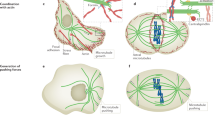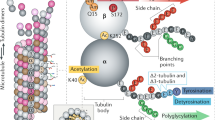Abstract
The number, length, distribution and polarity of microtubules are largely controlled by microtubule-organizing centres, which nucleate and anchor microtubule minus ends in a process that requires γ-tubulin. Here we discuss recent evidence indicating that γ-tubulin-dependent formation of new microtubules is not restricted to conventional microtubule-organizing centres. These findings suggest that the spatio-temporal control of microtubule nucleation is more complex than previously thought, leading us to a re-evaluation of the concept of the microtubule-organizing center.
This is a preview of subscription content, access via your institution
Access options
Subscribe to this journal
Receive 12 print issues and online access
$189.00 per year
only $15.75 per issue
Buy this article
- Purchase on Springer Link
- Instant access to full article PDF
Prices may be subject to local taxes which are calculated during checkout




Similar content being viewed by others
References
Pickett-Heaps, J. D. The evolution of the mitotic apparatus, an attempt at comparative ultrastructural cytology in dividing cell plants. Cytobios 1, 257–280 (1969).
Wittmann, T., Hyman, A. & Desai, A. The spindle: a dynamic assembly of microtubules and motors. Nature Cell Biol. 3, E28–E34 (2001).
Galjart, N. CLIPs and CLASPs and cellular dynamics. Nature Rev. Mol. Cell Biol. 6, 487–498 (2005).
Khodjakov, A., Cole, R. W., Oakley, B. R. & Rieder, C. L. Centrosome-independent mitotic spindle formation in vertebrates. Curr. Biol. 10, 59–67 (2000).
Hinchcliffe, E. H., Miller, F. J., Cham, M., Khodjakov, A. & Sluder, G. Requirement of a centrosomal activity for cell cycle progression through G1 into S phase. Science 291, 1547–1550 (2001).
Basto, R. et al. Flies without centrioles. Cell 125, 1375–1386 (2006).
Oakley, C. E. & Oakley, B. R. Identification of γ-tubulin, a new member of the tubulin superfamily encoded by mipA gene of Aspergillus nidulans. Nature 338, 662–664 (1989).
Oakley, B. R., Oakley, C. E., Yoon, Y. & Jung, M. K. γ-tubulin is a component of the spindle pole body that is essential for microtubule function in Aspergillus nidulans. Cell 61, 1289–1301 (1990).
Gunawardane, R. N., Martin, O. C. & Zheng, Y. Characterization of a new γ TuRC subunit with WD repeats. Mol. Biol. Cell 14, 1017–1026 (2003).
Luders, J., Patel, U. K. & Stearns, T. GCP-WD is a γ-tubulin targeting factor required for centrosomal and chromatin-mediated microtubule nucleation. Nature Cell Biol. 8, 137–147 (2006).
Haren, L. et al. NEDD1-dependent recruitment of the γ-tubulin ring complex to the centrosome is necessary for centriole duplication and spindle assembly. J. Cell Biol. 172, 505–515 (2006).
Fuller, S. D. et al. The core of the mammalian centriole contains γ-tubulin. Curr. Biol. 5, 1384–1393 (1995).
Wiese, C. & Zheng, Y. A new function for the γ-tubulin ring complex as a microtubule minus-end cap. Nature Cell Biol. 2, 358–364 (2000).
Mogensen, M. M., Malik, A., Piel, M., Bouckson-Castaing, V. & Bornens, M. Microtubule minus-end anchorage at centrosomal and non-centrosomal sites: the role of ninein. J. Cell Sci. 113, 3013–3023 (2000).
Delgehyr, N., Sillibourne, J. & Bornens, M. Microtubule nucleation and anchoring at the centrosome are independent processes linked by ninein function. J. Cell Sci. 118, 1565–1575 (2005).
Mogensen, M. M. Microtubule release and capture in epithelial cells. Biol. Cell 91, 331–341 (1999).
Andersen, J. S. et al. Proteomic characterization of the human centrosome by protein correlation profiling. Nature 426, 570–574 (2003).
Schmit, A. C. Acentrosomal microtubule nucleation in higher plants. Int. Rev. Cytol. 220, 257–289 (2002).
Ehrhardt, D. W. & Shaw, S. L. Microtubule dynamics and organization in the plant cortical array. Annu. Rev. Plant Biol. 57, 859–875 (2006).
Binarova, P. et al. γ -tubulin is essential for acentrosomal microtubule nucleation and coordination of late mitotic events in Arabidopsis. Plant Cell 18, 1199–1212 (2006).
Pastuglia, M. et al. γ -tubulin is essential for microtubule organization and development in Arabidopsis. Plant Cell 18, 1412–1425 (2006).
Murata, T. et al. Microtubule-dependent microtubule nucleation based on recruitment of γ-tubulin in higher plants. Nature Cell Biol. 7, 961–968 (2005).
Mazia, D. Centrosomes and mitotic poles. Exp. Cell Res. 153, 1–15 (1984).
Tassin, A. M., Maro, B. & Bornens, M. Fate of microtubule-organizing centers during myogenesis in vitro. J. Cell Biol. 100, 35–46 (1985).
Musa, H., Orton, C., Morrison, E. E. & Peckham, M. Microtubule assembly in cultured myoblasts and myotubes following nocodazole induced microtubule depolymerisation. J. Muscle Res. Cell Motil. 24, 301–308 (2003).
Bugnard, E., Zaal, K. J. & Ralston, E. Reorganization of microtubule nucleation during muscle differentiation. Cell Motil. Cytoskeleton 60, 1–13 (2005).
Hagiwara, H., Kano, A., Aoki, T., Ohwada, N. & Takata, K. Localization of γ-tubulin to the basal foot associated with the basal body extending a cilium. Histochem. J. 32, 669–671 (2000).
Hard, R. & Rieder, C. L. Muciliary transport in newt lungs: the ultrastructure of the ciliary apparatus in isolated epithelial sheets and in functional Triton-extracted models. Tissue Cell 15, 227–243 (1983).
Sawin, K. E. & Tran, P. T. Cytoplasmic microtubule organization in fission yeast. Yeast 23, 1001–1014 (2006).
Zimmerman, S., Tran, P. T., Daga, R. R., Niwa, O. & Chang, F. Rsp1p, a J domain protein required for disassembly and assembly of microtubule organizing centers during the fission yeast cell cycle. Dev. Cell 6, 497–509 (2004).
Janson, M. E., Setty, T. G., Paoletti, A. & Tran, P. T. Efficient formation of bipolar microtubule bundles requires microtubule-bound γ-tubulin complexes. J. Cell Biol. 169, 297–308 (2005).
Daga, R. R., Lee, K. G., Bratman, S., Salas-Pino, S. & Chang, F. Self-organization of microtubule bundles in anucleate fission yeast cells. Nature Cell Biol. 8, 1108–1113 (2006).
Carazo-Salas, R. E. & Nurse, P. Self-organization of interphase microtubule arrays in fission yeast. Nature Cell Biol. 8, 1102–1107 (2006).
Reilein, A. & Nelson, W. J. APC is a component of an organizing template for cortical microtubule networks. Nature Cell Biol. 7, 463–473 (2005).
Reilein, A., Yamada, S. & Nelson, W. J. Self-organization of an acentrosomal microtubule network at the basal cortex of polarized epithelial cells. J. Cell Biol. 171, 845–855 (2005).
Chabin-Brion, K. et al. The Golgi complex is a microtubule-organizing organelle. Mol. Biol. Cell 12, 2047–2060 (2001).
Rios, R. M., Sanchis, A., Tassin, A. M., Fedriani, C. & Bornens, M. GMAP-210 recruits γ-tubulin complexes to cis-Golgi membranes and is required for Golgi ribbon formation. Cell 118, 323–335 (2004).
Barr, F. A. & Egerer, J. Golgi positioning: are we looking at the right MAP? J. Cell Biol. 168, 993–998 (2005).
Lajoie-Mazenc, I. et al. Recruitment of antigenic γ-tubulin during mitosis in animal cells: presence of γ-tubulin in the mitotic spindle. J. Cell Sci. 107, 2825–2837 (1994).
Mastronarde, D. N., McDonald, K. L., Ding, R. & McIntosh, J. R. Interpolar spindle microtubules in PTK cells. J. Cell Biol. 123, 1475–1489 (1993).
Buster, D., McNally, K. & McNally, F. J. Katanin inhibition prevents the redistribution of γ-tubulin at mitosis. J. Cell Sci. 115, 1083–1092 (2002).
Gruss, O. J. & Vernos, I. The mechanism of spindle assembly: functions of Ran and its target TPX2. J. Cell Biol. 166, 949–955 (2004).
Wilde, A. & Zheng, Y. Stimulation of microtubule aster formation and spindle assembly by the small GTPase Ran. Science 284, 1359–1362 (1999).
Mahoney, N. M., Goshima, G., Douglass, A. D. & Vale, R. D. Making microtubules and mitotic spindles in cells without functional centrosomes. Curr. Biol. 16, 564–569 (2006).
Khodjakov, A., Copenagle, L., Gordon, M. B., Compton, D. A. & Kapoor, T. M. Minus-end capture of preformed kinetochore fibers contributes to spindle morphogenesis. J. Cell Biol. 160, 671–683 (2003).
Maiato, H., Rieder, C. L. & Khodjakov, A. Kinetochore-driven formation of kinetochore fibers contributes to spindle assembly during animal mitosis. J. Cell Biol. 167, 831–840 (2004).
Knop, M. & Schiebel, E. Spc98p and Spc97p of the yeast γ-tubulin complex mediate binding to the spindle pole body via their interaction with Spc110p. EMBO J. 16, 6985–6995 (1997).
Knop, M. & Schiebel, E. Receptors determine the cellular localization of a γ-tubulin complex and thereby the site of microtubule formation. EMBO J. 17, 3952–3967 (1998).
Sawin, K. E., Lourenco, P. C. & Snaith, H. A. Microtubule nucleation at non-spindle pole body microtubule-organizing centers requires fission yeast centrosomin-related protein mod20p. Curr. Biol. 14, 763–775 (2004).
Venkatram, S. et al. Identification and characterization of two novel proteins affecting fission yeast γ-tubulin complex function. Mol. Biol. Cell 15, 2287–2301 (2004).
Samejima, I., Lourenco, P. C., Snaith, H. A. & Sawin, K. E. Fission yeast mto2p regulates microtubule nucleation by the centrosomin-related protein mto1p. Mol. Biol. Cell 16, 3040–3051 (2005).
Venkatram, S., Jennings, J. L., Link, A. & Gould, K. L. Mto2p, a novel fission yeast protein required for cytoplasmic microtubule organization and anchoring of the cytokinetic actin ring. Mol. Biol. Cell 16, 3052–3063 (2005).
Zimmerman, S. & Chang, F. Effects of γ-tubulin complex proteins on microtubule nucleation and catastrophe in fission yeast. Mol. Biol. Cell 16, 2719–2733 (2005).
do Carmo Avides, M. & Glover, D. M. Abnormal spindle protein, Asp, and the integrity of mitotic centrosomal microtubule organizing centers. Science 283, 1733–1735 (1999).
Takahashi, M., Yamagiwa, A., Nishimura, T., Mukai, H. & Ono, Y. Centrosomal proteins CG-NAP and kendrin provide microtubule nucleation sites by anchoring γ-tubulin ring complex. Mol. Biol. Cell 13, 3235–3245 (2002).
Casenghi, M. et al. Polo-like kinase 1 regulates Nlp, a centrosome protein involved in microtubule nucleation. Dev. Cell 5, 113–125 (2003).
Terada, Y., Uetake, Y. & Kuriyama, R. Interaction of Aurora-A and centrosomin at the microtubule-nucleating site in Drosophila and mammalian cells. J. Cell Biol. 162, 757–763 (2003).
Zimmerman, W. C., Sillibourne, J., Rosa, J. & Doxsey, S. J. Mitosis-specific anchoring of γ tubulin complexes by pericentrin controls spindle organization and mitotic entry. Mol. Biol. Cell 15, 3642–3657 (2004).
Anders, A., Lourenco, P. C. & Sawin, K. E. Non-core components of the fission yeast γ-tubulin complex. Mol. Biol. Cell 17, 5075–5093 (2006).
Verollet, C. et al. Drosophila melanogaster γ-TuRC is dispensable for targeting γ-tubulin to the centrosome and microtubule nucleation. J. Cell Biol. 172, 517–528 (2006).
Vogt, N., Koch, I., Schwarz, H., Schnorrer, F. & Nusslein-Volhard, C. The γTuRC components Grip75 and Grip128 have an essential microtubule-anchoring function in the Drosophila germline. Development 133, 3963–3972 (2006).
Vogel, J. et al. Phosphorylation of γ-tubulin regulates microtubule organization in budding yeast. Dev. Cell 1, 621–631 (2001).
Stumpff, J., Kellogg, D. R., Krohne, K. A. & Su, T. T. Drosophila Wee1 interacts with members of the γTURC and is required for proper mitotic-spindle morphogenesis and positioning. Curr. Biol. 15, 1525–1534 (2005).
Starita, L. M. et al. BRCA1-dependent ubiquitination of γ-tubulin regulates centrosome number. Mol. Cell. Biol. 24, 8457–8466 (2004).
Acknowledgements
We thank M.-F. Bryan Tsou for critical reading of the manuscript and E. Vladar for helpful comments.
Author information
Authors and Affiliations
Corresponding author
Ethics declarations
Competing interests
The authors declare no competing financial interests.
Related links
Rights and permissions
About this article
Cite this article
Lüders, J., Stearns, T. Microtubule-organizing centres: a re-evaluation. Nat Rev Mol Cell Biol 8, 161–167 (2007). https://doi.org/10.1038/nrm2100
Issue Date:
DOI: https://doi.org/10.1038/nrm2100



